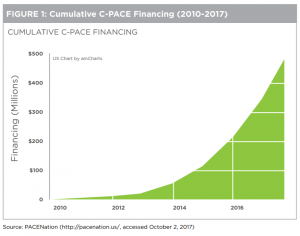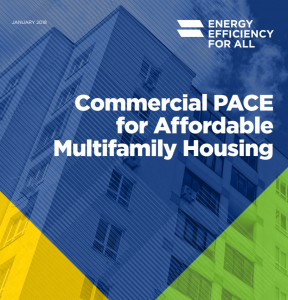New Study on Using C-PACE in the Affordable Multifamily Sector
Developed on behalf of the Energy Efficiency For All Project, the Vermont Energy Investment Corporation just released a report, Commercial PACE for Affordable Multifamily Housing, looking into the handful of affordable multifamily transactions that have used Commercial Property Assessed Clean Energy financing, or C-PACE.

Growth of C-PACE in the US since 2010
In the past seven years, C-PACE financing has grown exponentially across the U.S. In fact, the latest numbers from PACENation show that there has been $521 million in C-PACE assessments funded through 1,157 projects. However, very few affordable multifamily housing stakeholders have taken advantage of this financing mechanism. Therefore, the purpose of this report was to explore whether or not C-PACE can be used to fill a financing gap for energy efficiency in the affordable multifamily buildings sector, and if so, to identify the best practices.
Several theories exist as to why C-PACE has not been commonly used in the affordable multifamily sector. However, the case for using C-PACE in affordable multifamily housing is strong:
- Tax assessment, not a loan
- Off balance sheet
- Based on owner’s equity rather than future income
- Structured to recoup savings to cover costs
- Potential to fill financing gaps
Through cataloging existing C-PACE programs that have either been used by or created for the affordable multifamily sector, the study revealed the following findings:
- There have been few C-PACE transactions within the affordable multifamily housing sector.
- Most of the completed transactions have had relatively simple financing structures.
- Thus far, only one C-PACE deal has been used on a U.S. Department of Housing and Urban Development (HUD) financed property, and only one deal used on an affordable, multifamily transaction using the Low-Income Housing Tax Credit (LIHTC).
- The differences in each state’s enabling legislation have not led to substantive differences for C-PACE program administrators. However, these variations at the local and state level could hinder the ability of capital across state borders.
- There could be difficulties using C-PACE on new construction due to the difficulty of determining the Savings to Investment Ratio (SIR).
Based on these findings, the authors were able to compile best practices and recommendations for using C-PACE with affordable multifamily properties:
For Policymakers and Program Administrators-
- Encourage open PACE program design
- Identify and pursue opportunities with the fewest barriers
- Encourage opportunities in public housing
- Increase and document communication with HUD
- Require cost-effective investments
- Consider local development corporations (LDCs)
- Consider extended financing terms rather than rate buy downs
- Consider potential in USDA properties
For Affordable Housing Stakeholders Implementing C-PACE-
- Consider C-PACE as gap financing
- Prioritize C-PACE for recapitalization, not for mid-cycle retrofits
- Encourage state housing finance agencies involvement
- Continue to document and codify the use of C-PACE in multifamily affordable housing

Energy efficiency improvements in affordable multifamily housing reduces energy burdens for residents and helps preserve this important housing stock. The Commercial PACE for Affordable Multifamily Housing study shows that there are instances where C-PACE could help unlock additional energy savings in multifamily properties. Benefits of C-PACE should not just be enjoyed by the commercial and industrial sectors; there is a lot of potential for C-PACE to benefit the multifamily sector.
Click here to read the entire report.
The VAEEC is committed to accelerating the implementation and utilization of C-PACE throughout the Commonwealth. Along with our PACE technical consultant, Abacus Property Solutions, the VAEEC has been intimately involved in C-PACE education and outreach with stakeholders, including localities, property owners and developers, contractors, and lenders, to build a coalition of supporters and to encourage localities to move forward with developing C-PACE programs. Additionally, we have been working with stakeholders to develop a model ordinance and with our Mid-Atlantic PACE Alliance, or MAPA, partners to develop regional guidelines to accelerate the implementation of successful C-PACE programs throughout the Commonwealth and Mid-Atlantic region.
This study found that the high cost of C-PACE financing compared to the low cost of capital through federal or state backed housing loans is a barrier. However, in speaking with the Virginia Housing and Development Authority (VHDA) and other LIHTC experts in the Commonwealth, these low cost loans have specific restrictions that limit the ability to go beyond the standard needs of a building. In this instance, C-PACE can provide financing for measures that cannot be underwritten by HUD or VHDA, such as solar photovoltaics.
Additionally, the study briefly mentions the interaction of C-PACE on new construction and the challenges it can entail. The VAEEC has begun reaching out and working with stakeholders across the country who have experience using C-PACE with new construction to compile a list of best practices and lessons learned. This includes a list of projects that should qualify for C-PACE financing, how to determine the Savings to Investment ratio (SIR), and how to determine what percentage of the construction costs are eligible for C-PACE financing. We will continue this outreach in an effort to provide guidance to stakeholders hoping to use C-PACE on new construction in Virginia and the Mid-Atlantic region.
The VAEEC agrees with the study’s findings about the potential of C-PACE within the multifamily sector. In fact, this is a sector that we intend to focus on more in 2018. We will be working with our members, partners, and stakeholders to increase the awareness and knowledge of C-PACE within the multifamily sector.
To learn more about the basics of C-PACE, view the VAEEC PACE webpage, factsheet, or PACE video.
